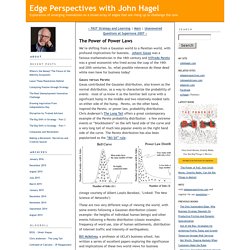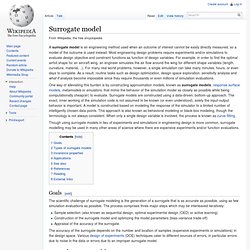

The Power of Power Laws. We’re shifting from a Gaussian world to a Paretian world, with profound implications for business.

Johann Gauss was a famous mathematician in the 18th century and Vilfredo Pareto was a great economist who lived across the cusp of the 19th and 20th centuries. So, what possible relevance do these dead white men have for business today? Gauss versus ParetoGauss contributed the Gaussian distribution, also known as the normal distribution, as a way to characterize the probability of events – most of us know it as the familiar bell curve with a significant hump in the middle and two relatively modest tails on either side of the hump.
Pareto, on the other hand, inspired the Pareto, or power law, probability distribution. The Cynefin Framework. Longitude. The Power of Power Laws. Type I and type II errors. In statistics , a type I error (or error of the first kind ) is the incorrect rejection of a true null hypothesis .

A type II error (or error of the second kind ) is the failure to reject a false null hypothesis. [ 1 ] A type I error is a false positive. Usually a type I error leads one to conclude that a thing or relationship exists when really it doesn't, for example, that a patient has a disease being tested for when really the patient does not have the disease, or that a medical treatment cures a disease when really it doesn't. A type II error is a false negative. All statistical hypothesis tests have a probability of making type I and type II errors. For example, all blood tests for a disease will falsely detect the disease in some proportion of people who don't have it, and will fail to detect the disease in some proportion of people who do have it. Statistical test theory [ edit ] Type I error [ edit ] False positive error [ edit ] Type II error [ edit ] Example [ edit ] ...
Surrogate model. A surrogate model is an engineering method used when an outcome of interest cannot be easily directly measured, so a model of the outcome is used instead.

Most engineering design problems require experiments and/or simulations to evaluate design objective and constraint functions as function of design variables. For example, in order to find the optimal airfoil shape for an aircraft wing, an engineer simulates the air flow around the wing for different shape variables (length, curvature, material, ..). For many real world problems, however, a single simulation can take many minutes, hours, or even days to complete. As a result, routine tasks such as design optimization, design space exploration, sensitivity analysis and what-if analysis become impossible since they require thousands or even millions of simulation evaluations.
Goals[edit] The accuracy of the surrogate depends on the number and location of samples (expensive experiments or simulations) in the design space. 1. 1. Aging boomers who can’t drive will be trapped in unwalkable cities of their own making. Judging by how pedestrian-unfriendly the average American city has become, all our aging parents apparently enjoy being prisoners in their own homes, reports the AP.

Because, oops: There comes a point when you can’t legally drive any longer. And if you depend on your car, that means you’ll have to … depend on your children instead. Fuck. For those who don’t have built-in chauffers/gofers with 18 years of debt to pay off, though, it could be a matter of life and death. [D]windling budgets in a tight economy have pushed communities to cut spending on delivering meals to the homebound and shuttling folks who can no longer drive to grocery stores and doctor’s offices. Between 2000 and 2030, the number of people over the age of 65 will double, representing 1 out of every 5 Americans.
Some states have it worse than others. Just eight years from now, researchers say, a quarter of all Ohio’s residents in half of the state’s counties will be 60 or older. Chris Anderson - Introducing The Long Tail - CWF08 - 06. Discovering power laws and removing “shit” TechnicalTerms. Defining the Big Shift. Risk and Resilience.